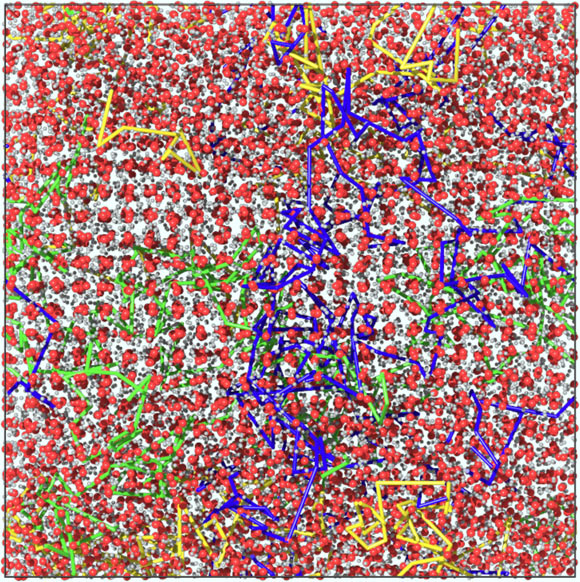
Using machine learning, a team of physicists at Lawrence Livermore National Laboratory has studied the phase behaviors of superionic water — a phase of water where hydrogen atoms become liquid-like while oxygen atoms remain solid-like on a crystalline lattice — with unprecedented resolution.
Hydrogen atoms diffuse easily between the superionic and the liquid phases. The liquid-fcc superionic interface of a water system with 20,736 atoms at 100 GPa and 3,250 K (on the melting curve) is shown. The oxygen atoms are red and the hydrogen atoms are white. The yellow, green and blue lines show the trajectories of three hydrogen atoms during a 75 ps molecular dynamics simulation run. Image credit: Cheng et al., doi: 10.1038/s41567-021-01334-9.
Water is the dominant constituent of Uranus’ and Neptune’s mantles, and superionic water is believed to be stable at depths greater than about one-third of the radius of these ice-giant planets.
Although superionic water was postulated over three decades ago, its optical properties (it is partially opaque) and oxygen lattices were only accurately measured recently, and many properties are still uncharted.
Understanding its properties is crucial for planetary science but difficult to probe experimentally or theoretically.
Quantum-mechanical simulations of superionic water have traditionally been limited to short simulation times and small system size, leading to significant uncertainty in the location of phase boundaries such as the melting line.
In the new research, Dr. Sebastien Hamel of Lawrence Livermore National Laboratory and colleagues made a leap forward in its ability to treat large system sizes and long-time scales by making use of machine learning techniques to learn the atomic interactions from quantum mechanical calculations.
The researchers then used that machine-learned potential to drive the molecular dynamics and enable the use of advanced free energy sampling methods to accurately determine the phase boundaries.
“We use machine learning and free energy methods to overcome the limitations of quantum mechanical simulations, and characterize hydrogen diffusion, superionic transitions and phase behaviors of water at extreme conditions,” Dr. Hamel said.
The authors found that phase boundaries, which are consistent with the existing experimental observations, help resolve the fractions of insulating ice, different superionic phases and liquid water inside of ice giants.
“Our quantitative understanding of superionic water sheds light into the interior structure, evolution and magnetic fields of planets such as Uranus and Neptune and also of the increasing number of icy exoplanets,” Dr. Hamel said.
The study was published in the journal Nature Physics.
_____
B. Cheng et al. Phase behaviours of superionic water at planetary conditions. Nat. Phys, published online September 23, 2021; doi: 10.1038/s41567-021-01334-9
 #Bizwhiznetwork.com Innovation ΛI |Technology News
#Bizwhiznetwork.com Innovation ΛI |Technology News



